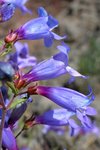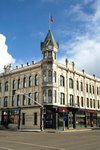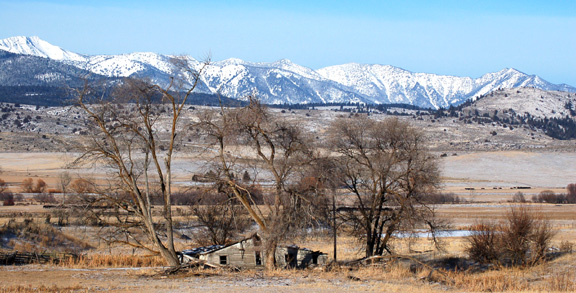The Vaux's Swift
Yesterday, as I traveled west during "rush hour" on Campbell, to its intersection with Main Street, I noticed a large swarm of birds over the intersection and the beautiful old home on the south west corner, at 2419 Main. Recognizing them as Vaux's Swifts, which I normally only see in much smaller groups, most often flying over local forests, I pulled into the parking area at Bisnett Insurance to see if they were going to do their thing and fly down the chimney at the two story home to roost for the night.
 Large, loose counter-clockwise swirl of swifts over a fine old home and chimney at 2419 Main Street during "rush hour." Photo includes a minor fraction of the swifts present.
Large, loose counter-clockwise swirl of swifts over a fine old home and chimney at 2419 Main Street during "rush hour." Photo includes a minor fraction of the swifts present.I vaguely remembered that the home had been mentioned by others as a sometime roost site, and was excited by the thought that the spectacle was about to happen on such a congested corner, right here in Baker City at "rush hour." It was about 3:55 PM on a cloudy, somewhat rainy day, and as I approached the corner with an older camera that I carry for other purposes, the smell of exhaust fumes from the traffic was evident to even my somewhat insensitive nose. I wondered what the effect would be on the birds as they circled over the home and exhaust-filled intersection.
They seemed unperturbed by the traffic and exhaust fumes, as they continued to circle counter-clockwise in a large, loose, swirling swarm of swifts, approaching the chimney on the old home, but then shying off entry to join the circle once again. At about 4 pm, when I was watching from the north east corner of the intersection, some of the birds in the group dropped straight down into the chimney, while others flew back into the swirl. Within about two or three minutes, most of the birds had literally dropped into the chimney on succeeding passes.
I was able to get a few photos with a small lens on the old camera as they went in.
 Swifts approach from the upper left and drop down into the chimney. Not exactly the crowded vortex seen with larger groups, but you get the idea.
Swifts approach from the upper left and drop down into the chimney. Not exactly the crowded vortex seen with larger groups, but you get the idea.Here are two more photos of the swifts dropping in to their communal roost site:
 Small group of swifts dropping into chimney
Small group of swifts dropping into chimney The last few of another small group as they entered the chimney. You can see the wings of the last few birds of the group as they enter.
The last few of another small group as they entered the chimney. You can see the wings of the last few birds of the group as they enter.I was able to talk to the occupants of the home, Nanci Sheppard and Thommy Whitlock, and they told me that they have come to roost since April of 2005, and enter the chimney roost early if it is cloudy, like yesterday, but roost around dusk when it is sunny. They circle for about twenty minutes. Another observer told them there have been about 300 birds in recent weeks. They also said that they do not hear the birds in the chimney from within the house.
They stated that the swifts come in during the migration north in spring, late April and early May, and at least some will stay for perhaps a month and a half, and then head north and elsewhere. The birds used to also roost at a chimney in a home on Valley Avenue, but since that chimney was closed off, they come to their home. They appreciate the birds and keep the chimney open (and without a fire below) so that they have a place to roost during migration. They usually return to migratory communal roosts, such as this one, on the way south in Oregon around August. Only a relative few are around in winter.
As for spraying by County vector control of the swift's food supply, mosquitos and other flying insects within the city and surrounding environs, they "hate it," but think they understand the need for mosquito control also.
The 1940 edition of Oregon State College's Gabrielson and Jewett publication, titled "Birds of Oregon," described the communal roosting scene of a much larger group in an East Portland, Oregon, chimney:
"The sight of this company of rapidly moving birds circling about the chimney like a large whirlpool, with the birds in the vortex dropping like plummets into the chimney, excited much interest among local bird lovers who made many trips to watch the performance."
A local bird expert, perhaps it was Joanne Britton or Anne Frost, described the birds in flight to me some time ago, as "cigars with wings." In the photos above, you might also find the silhouettes of birds that are significantly larger and do not fit the description. They are likely interested avian predators, like the sharp-shinned hawk or American kestrel, and at other times even ravens or crows (R rated video below), looking for an early evening snack.
Videos:
Thousands of swifts at http://wdfw.wa.gov/wildwatch/vauxcam/video/evening_return.wvx
brutal crow cafe
The "Birds of Oregon" (1940) describes the bird as:
". . . a strong flier, its oarlike wings sending the slender body through the air at astonishing speed. Often the bird appears to work the wings alternately, and again, in orthodox fashion. Its speed far surpasses that of the swallows with which it often associates in migration, enabling the swift to dart past the swallows with no apparent effort."
Vaux's Swifts, "pronounced 'Vawks' rather than 'Voh,'" was brought to the attention of European American society by the short-lived famous American naturalist and Quaker, John Kirk Townsend (1809-1851) with a description in 1839 (He originally thought he was describing the eastern Chimney Swift.) See the new "Birds of Oregon," (Marshall, Hunter, & Contreras, 2006). Another local bird of sage brush and juniper, the Townsend's Solitaire, also bears his name.
These aerobic acrobats are not an uncommon sight in the forests of the Blue Mountains, including the Elkhorn and Wallowa Mountains in Baker County, but they range over much of the North and South American continents. Our bird, the northern subspecies, Chaetura vauxi vauxi, is larger than the southern subspecies, but both are smaller than their eastern cousin, the Chimney Swift. While they will roost and nest in chimneys, they are often associated with tall hollowed out snags of conifers, most especially in our region, in the commonly rotted out cores of an old grand fir.
They are somewhat dependent on old growth forests, which have been in severe decline historically, and their nests are affixed to the inner surfaces of chimneys and probably more often, to old hollow trees. Both the nest structure of twigs, and the nest connection to the inner wall, are cemented together by a "sticky saliva."
 Vaux's Swift, clinging to brick wall. (Photo from the Washington Division of Wildlife Services.)
Vaux's Swift, clinging to brick wall. (Photo from the Washington Division of Wildlife Services.)Bull and Beckwith, 1993, report that the primary diet is made up of Homoptera (Hemiptera), that is flying aphids and whiteflies, and their relatives (43%), along with prodigious quantities of Diptera (mosquitos, flies, gnats and midges--27%), along with many mayflies (18%) and other flying insects. (The sources I was able to access do not indicate whether the determination was made by weight or by numbers of insects.) In any event, their diet is a testimony to their value, from the perspective of humans hoping to be rid of mosquitos, so the effects of arial spraying of insecticides on their health and survival needs to be considered.
Conservation status in north east Oregon is uncertain. The new "Birds of Oregon," (Marshall, Hunter, & Contreras, 2006) states that:
"In 1990, Bull( 1991) observed about 100 swifts using a roost in a hollow tree all summer in ne. Oregon and suspected they were not nesting because nest sites were not available. In ne. Oregon, conversion of stands dominated by grand fir to an earlier seral stage dominated by ponderosa pine would probably further decrease the number of nest and roost sites because all nests and roosts located in this area were in grand fir trees (Bull 1991, Bull and Cooper 1991). Large diameter grand fir trees typically contain extensive heartwod decay which creates hollow chambers suitable for nesting; this same phenomenon rarely occurs in ponderosa pine. . . . . Additional research is warranted. . . ."
Other well known communal roosting sites in Eastern Oregon, according to the new "Birds of Oregon," (Marshall, Hunter, & Contreras, 2006) include:
"La Grande (4th and Adams), . . . Pendleton (318 S. Main), . . . Union (Union High School)."
5/25/12--Mary McCracken, of La Grande, reported seeing the the swifts circling the old Elgin High School in Elgin last night.
As the birders like to say--"good birding."












3 comments:
Nice Chris. I have to get down and see them sometime soon.
Thanks Jim. Supposed to be mostly cloudy today so hard to figure when they'll come home to roost. I'd like to try again at dusk on on a sunny day.
I very much enjoyed reading your essay and examining the great photos. Thanks.
Post a Comment